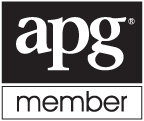How do you use Swedish Household Examinations in Genealogy?

Hello Everyone! How’s your week going? I have a really fun article this week. Well, I had fun creating it anyway. I love using household examinations. This is where I really get to know a family and find out how they lived. It’s not complete, but it helps me know them as people instead of just names on paper.
Our Family Case Study
Let’s start with the Swedish family Anders Modinsen and his wife Hanna Persdatter and their three children Christina, Hanna, and Christian. We are going to follow this family as close as we can through the household records and I will explain any changes that we see through their lives.
1826-1830
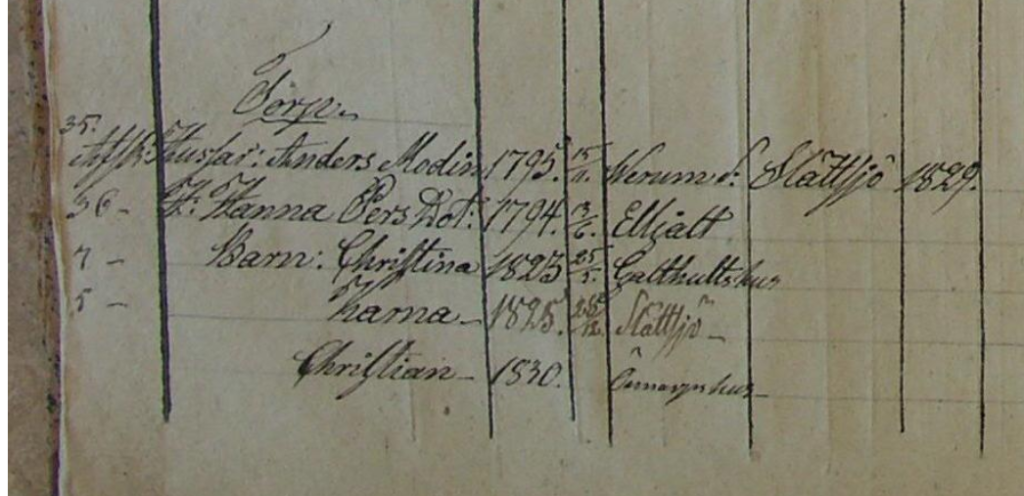
Here they are living in Onnarp Torp farm, Roke Parish, Kristianstad, Sweden. A torp is a small farm that is owned by one large main farm. It’s like a sharecropper’s farm that they don’t own, but just work the land. This screenshot shows the first line is Anders listed as head of household then his birth information. He was born 15 November 1795 in Werum. The next column shows that the family moved from Slattjo farm to Onnarp Torp farm in 1829. You can’t see the column headings in this screenshot, but the last two columns are for people moving from another place to Roke Parish. It will list their last residence.
The next line shows Hanna Persdatter, his wife, and she was born 13 June 1794 in Elliatt farm. Then the next line down shows their oldest daughter Christina born 25 May 1823 in Galthult farm. The next line is the second oldest daughter, Hanna, born 25 December 1825 in Slattjo farm. Finally, the last line shows their son, Christian, born 1830 in Onnarp farm. These farms are all in Roke Parish so they didn’t leave the parish, they just hopped to different farms.
Now that we’re familiar with this family, let’s look at the record book itself. This volume covers the years 1826-1830. If there were any changes to this family during this time, then it would be recorded in this book. For example, if someone died or married and left the family, then we would see it at the end of this page in the notes section. This family had none of that this time, so everything else on this page is blank because the family stayed on this farm until 1830.
Then to see them past 1830, we would go to the next household examinations volume and find that family living at Onnarp Torp farm. You would find them by looking in the farm index, the alphabetical person index, or by going page by page. Like this…
1831-1835
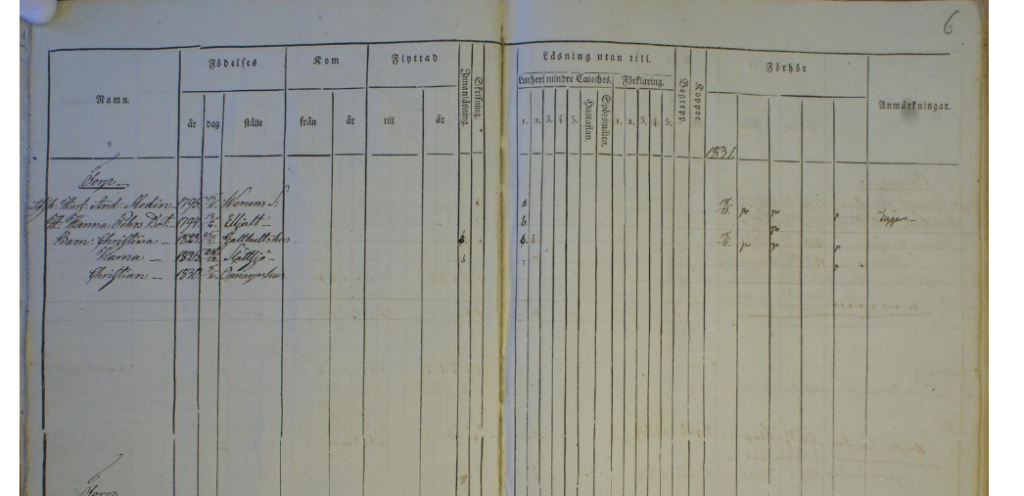
This might be a little small to read, but I wanted to show you what a full page looked like in these books. This volume covers the years 1831-1835. The family’s information is still the same and it looks like nothing has changed.
However, we can see over to the far right in the last column there is a word there. According to the Swedish Genealogical Word List on FamilySearchWiki, it says the word is “tyggare” and it means beggar. In other words, this family is very poor to be labeled as beggar on the records. Let’s go on to the next volume and see if it has anything else for this family.
1836-1841
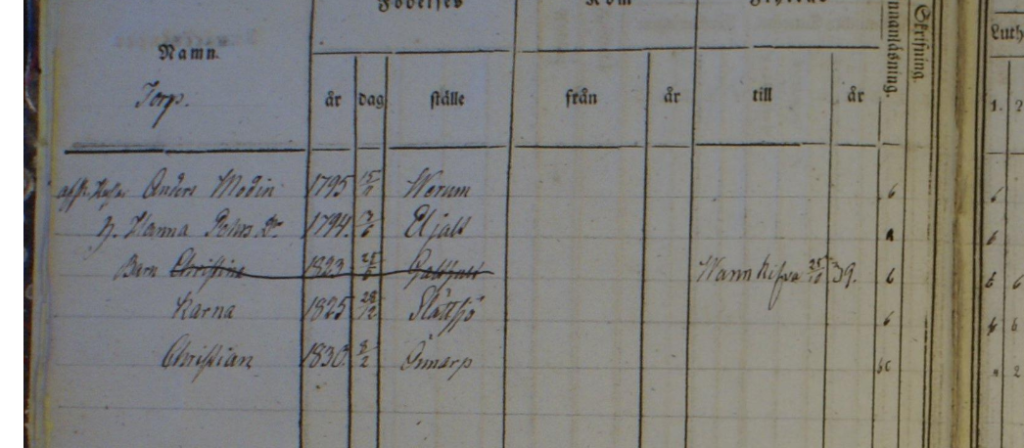
This volume covers the years 1836-1841. The family is still found at Onnarp Torp farm and all is relatively the same except we see some changes in the oldest daughter Christine’s information. When someone is crossed out on one of these household examinations it means they either died or moved out of the area.
So Christine is crossed out and over to the right we see in the right two columns the reason she is crossed out. It says Wamkifva 25 October 1839. This probably means she moved to this place, which is actually Vankiva Parish, in 1839. Since this volume covers until 1841, then her move would be entered in this book. We don’t know if she moved because she got married or if she got a job, but either way she moved from this farm. You can follow her by finding her in this farm’s household examinations book. Then you can continue her story from there. The family is still listed as beggar on this record as well.
But let’s stay with the main family and see what the next volume will hold for them.
1842-1845

The family has had some changes for these years. This volume covers the years 1842-1845. It appears that the other two children have been crossed out, which means they have left the farm. The daughter, Hanna, went to Vankiva Parish on 2 November 1842 and the son, Christian, went to Bronnestad Parish in 1845. The family is still listed as beggar, which you can’t see on this screen shot.
1846-1850
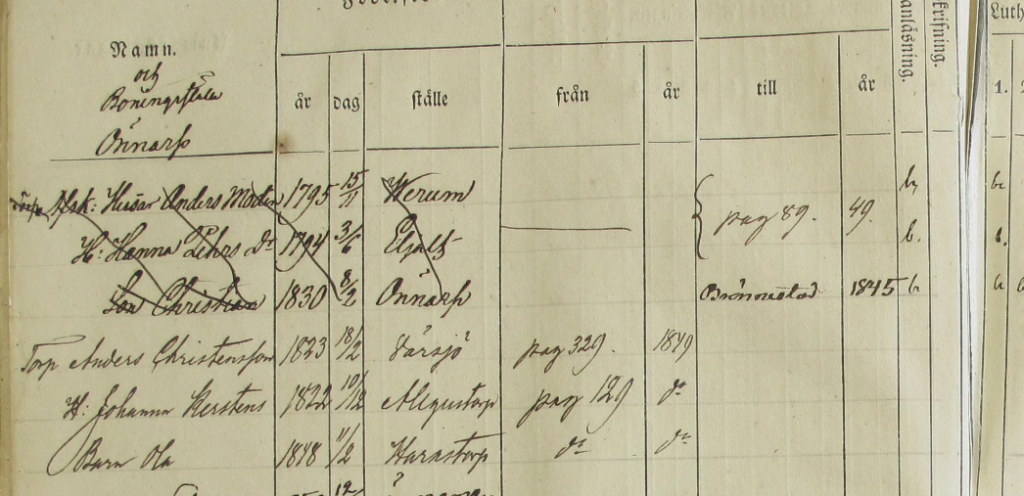
We next see the family in the volume covering 1846-1850. We see that the whole family has been crossed out. This means that they have moved. Therefore, we look in the columns to the right to find out where and we see a page number 89. They moved in 1849 and this is what we see on this page.
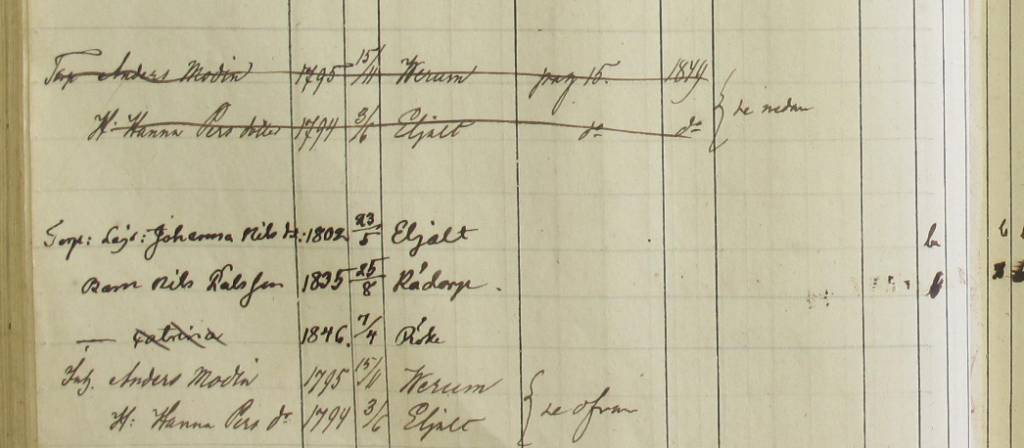
This one is particularly interesting. It appears they moved to Roke farm and they are listed twice on this page. The crossed out one looks like they were moving again. However, the word “le nedre” in the right hand column means “lower.” Therefore, we look lower and find them written again, this time not crossed out. This probably means they are staying in Roke farm for these years anyway. There is also another word on the right, “le ofrar.” My guess is that this actually is “ovre”, which means “upper.” This is probably referring to the family’s entry earlier on this page. That’s my guess anyway.
1851-1854
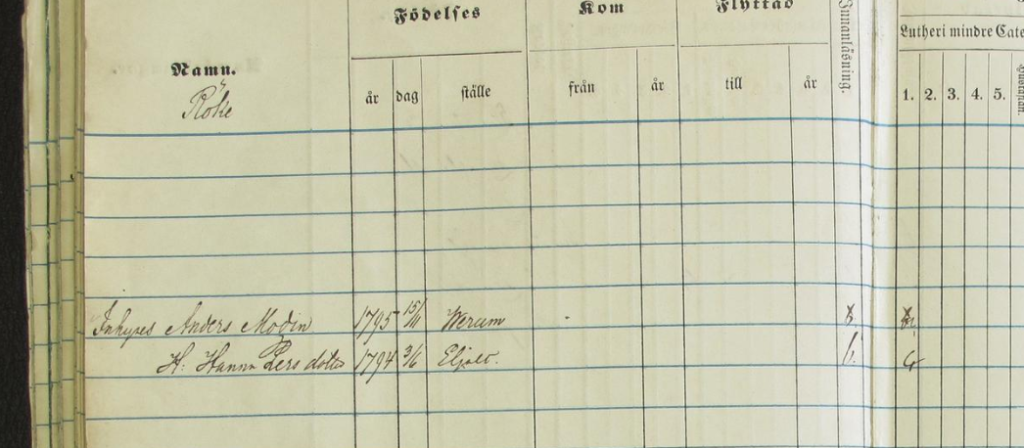
Again, we just continue the search. We find them next in the 1851-1854 volume living on Roke farm just the two of them. Their children are all grown and gone and no new changes are found in this book. If we wanted to follow the children, we would go to the last book that had where they moved and then follow them on. It would show when they married and where they moved from there.
I’m not going to post every screenshot of the couple because that would be too much. However, I would continue to follow the couple until they died. The priest would record their death date in the household examinations book. Then I would find their death record in the church book to verify the information.
Now there’s a lot more to these records that I didn’t cover because I didn’t want this post to be too long. I feel it’s already long enough. However, if you have more questions, then feel free to ask them. This is just a basic overview of how to use these records to find your ancestor. Not all of your ancestors will follow such a linear path like this family.
Conclusion
If you would like to see where I got this household examination information, then follow this link to find the exact location for these records. Then I would go ahead and practice following another family in this book to sharpen my Swedish searching skills. But that’s me and I’m a little weird like that.
If you’re still confused or want some more help, then check out my article here to learn more about household examinations. As always, I’m here to help when things look overwhelming. Just hang in there and take one step at a time. And enjoy the journey!
Good luck and happy hunting!
Tiffany
family, household examination records, how to use household examination records, Sweden

